10. Area and Average Value
b1. Area Between Two Curves
Here is a slight generalization of the area below a curve:
Find the area below a function \(y=f(x)\) above a function \(y=g(x)\) between \(x=a\) and \(x=b\).
We mimic what we did for the area under a curve.
We again divide the region into \(n\) rectangles each of width \(\Delta x=\dfrac{b-a}{n}\) but this time the height is \(f(x_i^*)-g(x_i^*)\) where \(x_i^*\) is a point in the \(i^\text{th}\) interval.
The area is then obtained by adding up the areas of the rectangles and taking the limit as the number of rectangles becomes large, (\(n\rightarrow\infty\)): \[ A=\lim_{n\rightarrow\infty}\sum_{i=1}^n [f(x_i^*)-g(x_i^*)]\Delta x \] This limit of a sum is recognized as the integral \[ A=\int_a^b [f(x)-g(x)]\,dx \] Here, \(f(x)\) is the upper function, while \(g(x)\) is the lower function.
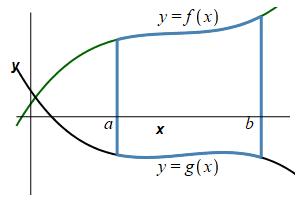
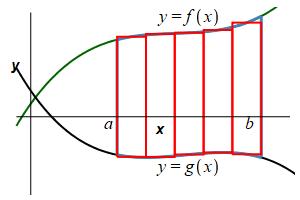
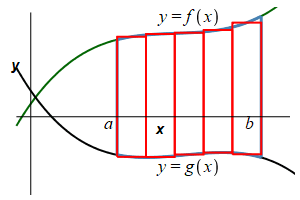
The area below a function \(y=f(x)\) above a function \(y=g(x)\) between \(x=a\) and \(x=b\) is: \[\begin{aligned} A&=\int_a^b [f(x)-g(x)]\,dx \\ &=\int_a^b (\text{upper}-\text{lower})\,dx \end{aligned}\] \
Plot the parabolas \(y=x^2-2x\) and \(y=-x^2+4x\) and find the area between them.
To graph the two parabolas, note the first parabola \(y=x^2-2x\) opens upward and has \(x\)-intercepts \(0\) and \(2\) while the second one \(y=-x^2+4x\) opens downward and has \(x\)-intercepts \(0\) and \(4\). To find where they intersect, we equate the functions and solve: \[\begin{aligned} x^2-2x&=-x^2+4x \\ 2x^2-6x&=0 \\ x&=0,3 \end{aligned}\] Then the area is
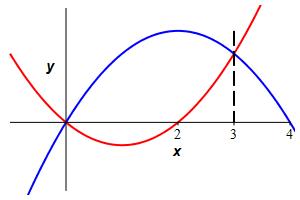
\[\begin{aligned} A&=\int_0^3 (\text{upper}-\text{lower})\,dx \\ &=\int_0^3 (-x^2+4x)-(x^2-2x)\,dx \\ &=\int_0^3 (-2x^2+6x)\,dx =\left[-2\dfrac{x^3}{3}+3x^2\right]_0^3=9 \end{aligned}\]
How do you know which is upper and which is lower?
The parabola \(y=-x^2+4x\) bends down because of the minus before the \(x^2\). So it is on top.
Now you try:
Plot the parabola \(y=x^2-4\) and the line \(y=3x\) and find the area between them.
To find the intersection points, we equate the functions: \[x^2-4=3x\]
\(\displaystyle A=\int_{-1}^4 [3x-(x^2-4)]\,dx=\dfrac{125}{6}\)
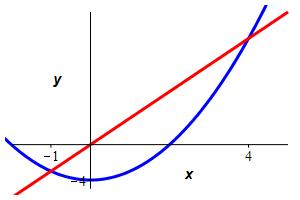
The parabola has \(y\)-intercept \(-4\) and opens up. The line passes thru the origin with positive slope. To find the intersection points, we equate the functions \[\begin{aligned} x^2-4&=3x \\ x^2-3x-4&=0 \\ (x-4)(x+1)&=0 \\ x&=-1,4 \end{aligned}\] So the area is

\[\begin{aligned} A &=\int_{-1}^4 [3x-(x^2-4)]\,dx \\ &=\int_{-1}^4 (3x-x^2+4)\,dx =\left[\dfrac{3x^2}{2}-\dfrac{x^3}{3}+4x\right]_{-1}^4 \\ &=\left(24-\dfrac{64}{3}+16\right) -\left(\dfrac{3}{2}+\dfrac{1}{3}-4\right) =\dfrac{125}{6} \end{aligned}\]
You can practice computing Areas between Curves by using the following Maplet (requires Maple on the computer where this is executed):
For now, just look at the problems where \(y\) is a function of \(x\).
Heading
Placeholder text: Lorem ipsum Lorem ipsum Lorem ipsum Lorem ipsum Lorem ipsum Lorem ipsum Lorem ipsum Lorem ipsum Lorem ipsum Lorem ipsum Lorem ipsum Lorem ipsum Lorem ipsum Lorem ipsum Lorem ipsum Lorem ipsum Lorem ipsum Lorem ipsum Lorem ipsum Lorem ipsum Lorem ipsum Lorem ipsum Lorem ipsum Lorem ipsum Lorem ipsum